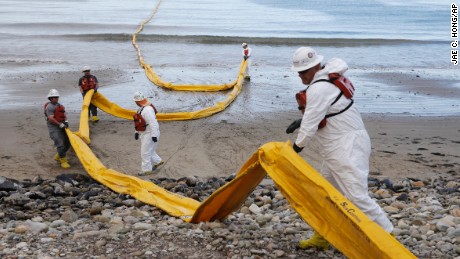

Now the Coastlines are hosting workers in hazmat suits. LA is feeling the repercussions as well; while the spill is said to have spread over 9 miles, Manhattan Beach in Los Angeles was closed due to oil globs arriving upon the shore.
http://abcnews.go.com/US/oily-substance-california-beach-prompts-officials-close-coastline/story?id=31360913
This is not the first time the wildlife of Santa Barbra has been met with an abundant supply of crude oil.
In 1969 a devastating oil spill covered 800 square miles of ocean and 35 miles of coastline in Santa Barbra. Millions of gallons of crude oil killed thousands of seabirds, seals, and dolphins and an innumerable amount of fish and sea life. According to this article, the sound of the waves were muted by the oil, and the smell of petroleum was pervasive.


This 1969 Santa Barbra oil spill impacted many, giving rise to grassroots environmental movements and legislation that focused on limiting Big Oil.
"• A broad environmental grassroots movement was founded leading to the first, Earth Day in November of 1969. (http://earthday.envirolink.org/history.html) • Get Oil Out (GOO) collected 100,000 signatures for a petition to ban offshore drilling • The Environmental Defense Center was founded (http://www.rain.org/~edc/) and the first Environmental Studies program was started at UC Santa Barbara (http://www.es.ucsb.edu/general_info/about.htm). • The California Coastal Commission was created from a statewide initiative. (http://www.coastal.ca.gov). This commission today has powerful control over human activities that impact California’s coastal areas. • The State Land Commission banned offshore drilling for 16 years, until the Reagan Administration took office. • President Nixon signed the National Environmental Policy Act of 1969 (http://es.epa.gov/oeca/ofa/nepa.html). Leading the way to the July 1970 establishment of the Environmental Protection Agency. • California Environmental Quality Act (CEQA) became law (http://ceres.ca.gov/ceqa). • Federal and state regulations governing oil drilling were strengthened. • A CIA owned U-2 Spy Plane took the first ever air photo reconnaissance images of Santa Barbara for peaceful purposes other than mapping of denied territory (Marx, 1984). • Federal Government founded the Civil Applications Committee, aimed at coordinating intelligence and military systems for national emergencies."
http://www.geog.ucsb.edu/~kclarke/Papers/SBOilSpill1969.pdf
Here is a list of the largest oil spills world wide, with the Gulf oil spill ranking second, leaking 206 million gallons of crude oil.
http://www.mnn.com/earth-matters/wilderness-resources/stories/the-13-largest-oil-spills-in-history
Now we face a new challenge: to keep Shell from drilling and spilling in the Arctic.
https://shellno.org/

Thanks for bringing the history behind this to light, it is unbelievable (like Nancy said) that this continues to happen over and over. Such irreparable damage to the ocean and wildlife, yet so little action against the drillers or preventative measures. I like your call to action at the end, with stopping Shell in the Arctic, and I am really glad environmental groups are fighting it in court!
ReplyDelete